PRODUCTS
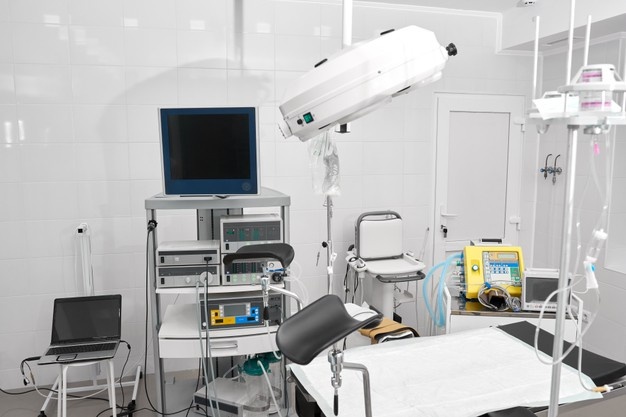
Obstetric equipment
When going to give birth, a woman wants this process to go through successfully, but in this matter, the presence of not only a qualified doctor is important. There should be quality equipment that will facilitate access to the patient. In addition, the equipment for the operating room in female gynecology creates a field for the working activity of surgeons: special models reduce possible risks for patients.
Modern options for a maternity hospital allow you to quickly conduct therapy, diagnostic studies, operations. The equipment present creates the conditions for monitoring the course of pregnancy, helps to take delivery correctly, and helps in the postpartum period. There are the following options:
- diagnostic devices;
- manipulation tools;
- devices for ultrasound and laser therapy;
- specialized chairs and beds for a private clinic;
- auxiliary accessories of the gynecological spectrum.
A variety of equipment has several important advantages, so the time comes when you need to purchase it because it is multifunctional and designed for accurate diagnosis.
For private women’s offices, the best equipment of the latest models will also be required. By visiting our website, you can purchase it at an affordable price. Currently, there are a lot of maternity hospitals, therefore a variety of models are in demand, but it must be said that high-quality options do not have to be expensive, you can pick up decent equipment and at a low price.
Diagnostic equipment
Medical diagnostic devices are various types of portable medical equipment with high research accuracy, used in the initial diagnosis and visual examination of the general condition of the patient. Most often, such computer equipment is equipped with offices of ophthalmologists, dermatologists, otolaryngologists, therapists, pulmonologists, and cardiologists, less often surgeons with the aim of:
- timely determination of organ diseases;
- the provision of medical care;
- inpatient observation of the patient;
- carrying out manipulations.
Our company, which supplies a wide range of modern diagnostic equipment from leading manufacturers of medical equipment, will help equip your multifunctional clinic with the latest equipment. All our devices have the appropriate quality certificates, are tested in operation, have high accuracy rates, and after-sales warranty service.
However, despite this, all medical diagnostic devices need to be checked, properly cared for, and correctly used:
- pay attention in advance to the temperature conditions recommended by the manufacturer during the operation of the devices;
- carry out the timely replacement of consumables;
- clean the device immediately after the procedure;
- use only approved disinfectants for device disinfection.
Ventilator devices
A ventilator is an oxygen breathing apparatus or an artificial lung ventilation apparatus designed to support the respiratory function of a person in case of its insufficiency or inability to breathe naturally. It is easier to perform mechanical ventilation using an anesthesia face mask or S-shaped airway. There are also portable air ducts, but they are less popular in medicine.
The principle of operation of mechanical ventilation is based on the forced supply of air mixture to the lungs, with the ability to change such parameters as oxygen concentration, pressure, frequency. It is a device consisting of a compressor and a system for supplying and discharging a gas mixture, equipped with sensors, valves, sealed nozzles, and a control unit.
The artificial lung ventilation device is connected invasively – air is supplied through an endotracheal tube introduced into the respiratory tract or through a tracheostomy and non-invasively – using a mask. If necessary, insert a tongue holder into the patient’s mouth. Endotracheal (intubation) anesthesia is currently the main type of inhalation anesthesia when performing extensive, traumatic abdominal operations. In cases where the victim has an obstruction of the airways at the level of inhalation into the larynx in the area of the vocal cords, an emergency conicotomy is indicated.
A modern breathing apparatus is a high-tech device that automatically maintains the patient’s respiratory function, with the ability to change the pressure, the volume of the dosed mixture, and its composition.
The new generation of ventilation devices allows you to synchronize your work with the state of the patient’s respiratory system as reliably and accurately as possible. They are controlled through feedback channels with the patient’s body. The signal processing unit receives control signals directly from the respiratory center of the medulla oblongata, and highly sensitive sensors of the apparatus are used to register them.
Cardiology equipment
Cardiological equipment is intended for the diagnosis and treatment of disorders in the work of the cardiovascular system. Modern devices for cardiology combine the achievements of engineering and design ideas, they widely use a microprocessor and mobile technologies. All this turns the cardiological equipment into an effective means for detecting the disease at the initial stage, which increases the effectiveness of the therapy.
Equally important is the use of cardiological equipment for the successful performance of surgical interventions. This category of devices is widely used in diagnostic and therapeutic departments, health centers, intensive care units, and anesthesiology.
The use of special equipment for cardiology is indicated during rehabilitation after heart attacks and other serious diseases of the heart and blood vessels and allows to reduce the number and frequency of complications.
This category of equipment includes:
- Defibrillators. Resuscitation equipment designed for emergency electro-impulse therapy in case of rhythm disturbances and cardiac arrest. There are devices with monopolar and bipolar impulses (the former are used less and less). In medical practice, professional devices are used, in which some parameters can be adjusted. Designed for resuscitators, ambulances. Electrodes applied to the patient’s chest are used to deliver a discharge. The devices are equipped with an LCD.
- Pulse oximeters. Apparatus for measuring the level of hemoglobin in the blood. They are used one-time or for long-term monitoring. The measurement results are displayed on the device display. They are used to control blood oxygen saturation in various lung pathologies. They belong to non-invasive devices, easy to operate and maintain. There are portable and stationary models. The measurement is carried out using a sensor that is worn on the finger. They are widely used not only for self-control but also in intensive care units, when transporting patients, etc.
- Fetal monitors or cardiographers. Used to record heart rate, fetal movements, hemoglobin concentration, and uterine contractions. The functionality of the instruments varies depending on the model. Manufacturers offer devices for stationary use, as well as devices equipped with wireless sensors, which allows performing the necessary diagnostics even while a woman is moving.
- Holter monitors. Designed for continuous recording of electrocardiogram and blood pressure indicators. The functional capabilities of the devices allow for automatic analysis of cardiac arrhythmias, statistical calculation. Form a detailed report on the violations identified with the inclusion of episodes of violations.
- Electrocardiographs. Portable and stationary devices for electrocardiogram registration. Equipped with LCDs, printing devices, special noise suppression circuits that minimize measurement errors.

Laboratory equipment
Modern medicine makes special requirements for diagnostics, which is associated with an increase in the level of medical care and the need to detect diseases at the earliest stages.
For these purposes, new high-tech models of analyzers are being developed, which make it possible to automatically and with high accuracy conduct clinical and biochemical blood tests. Also, this category of equipment includes laboratory microscopes for routine or general clinical research.
Manufacturers offer the following types of analyzers:
- Hematological. Devices for quantitative studies of blood cells. They have high productivity and can process over 100 blood samples per hour – with high accuracy and with the ability to store test results, as well as print them. The industry produces automatic and semi-automatic devices. Each model is designed to analyze a certain number of parameters (concentration of erythrocytes, leukocytes, platelets, hematocrit, etc.). They are a complex of various devices and systems: mechanical, hydraulic, measuring, etc.
- Biochemical. Devices that provide the ability to automatically and semi-automatically conduct clinical studies with the determination of the concentration of uric acid, bilirubin, lipids, creatinine, electrolytes, etc. There are devices for express tests, working on the technology of “dry chemistry”. The equipment has rich functionality and allows you to get the necessary results in the shortest possible time. Automatic models of analyzers perform all traditional operations, which include mixing reagents and blood samples, heating, analyzing results, performing calculations, etc. They are the optimal choice for large clinics where you have to deal with a large number of samples and parameters.
- Immunoassay. Laboratory instruments are used to determine the immune response of an antigen to the presence of antibodies. The equipment is highly sensitive and informative. Its application is the optimal solution for obtaining quick results in the diagnosis of almost any disease. They are indispensable for the detection of infectious diseases, can be used as a diagnostic tool in determining the early stages of pregnancy.
Anesthetic and respiratory devices
When performing complex surgical operations under general anesthesia, ventilation of the lungs is a necessary measure of patient safety. For this purpose, an anesthesia-respiratory apparatus is used – in the process of work, it supports the respiratory function of a person. The air mixture is supplied using endotracheal tubes or breathing masks.
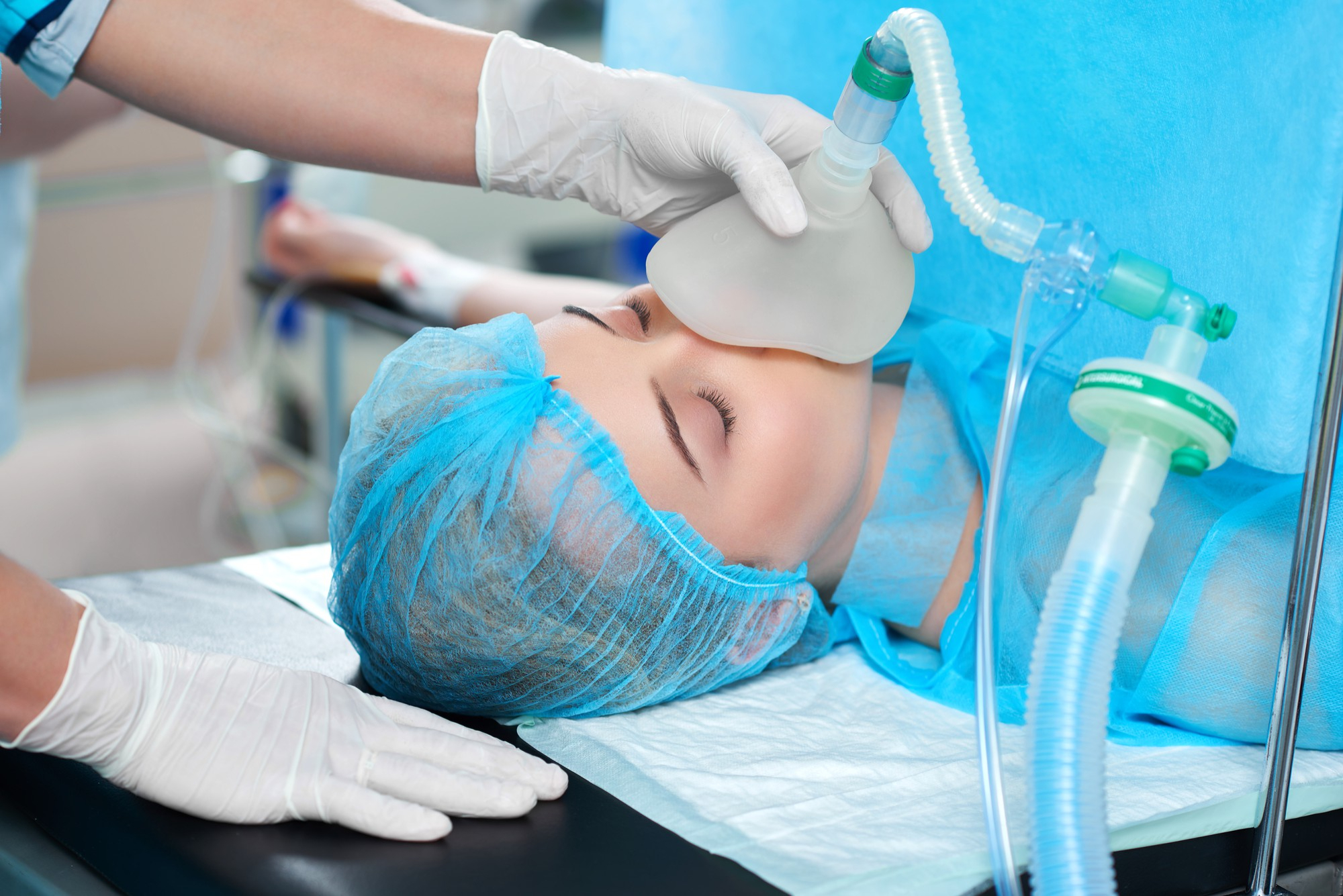
Regardless of the model of the anesthesia-respiratory apparatus, its work is carried out according to the following principle: the volume of anesthetics specified by the anesthesiologist is supplied to the patient’s lungs mixed with oxygen. All parameters of the device are determined depending on various factors: the reason for use (surgery or resuscitation), age, the health status of the patient.
The anesthesia apparatus consists of the following components:
- gas mixture supply systems;
- chambers where the components are mixed.
The gas mixture includes three main gases: oxygen, compressed air, nitrous oxide. All hoses of the device are color-coded, and the connectors are individually designed, which allows you to avoid mistakes when connecting them.
Almost every device on the market is equipped with a button that allows an emergency supply of pure oxygen. In most devices, work is monitored by volume: the switching of the breathing phases (inhalation/exhalation) is performed after the supply of a volume of air is determined by the doctor. In addition, manufacturers offer systems that switch the breathing cycle after reaching a predetermined level of airway pressure and also allow you to change the inhalation/exhalation ratio.
Anesthetic and respiratory devices have the following design features:
- Anesthetic ventilator type. Depending on the model, the fans can be pneumatically or electrically driven.
- Dosing device type (rotameter). Dosing of the anesthetic is carried out using a mechanical or electronic device.
- The number of supplied gases. Most modern anesthesia and breathing machines are designed to deliver 2 or 3 types of gas.
- Possibility of low-flow anesthesia. This feature can significantly reduce the consumption of anesthetics. This is achieved by cleaning the air exhaled by the patient and re-feeding it into the system. Additional advantages of such devices include the ability to maintain the optimum temperature and humidity of the mixture, which makes their use as safe as possible.
- Autonomous work. The device should continue to function during a power outage to allow the doctor to complete the operation. Battery life varies by model and can range from 45 to 120 minutes.
- Mode of application. A distinction is made between stationary and mobile devices. Portable breathing apparatus PDA is intended for use in emergency conditions or when it is necessary to carry out surgical intervention outside a medical institution.

Ophthalmic equipment
Ophthalmic equipment is designed for diagnostics and treatment of eye diseases in clinical diagnostic centers. A well-equipped ophthalmological office allows the doctor to establish an accurate diagnosis, which is the basis for successful treatment. The equipment allows you to test the acuity and field of vision, conduct an ultrasound examination of the visual organs, determine the degree of ametropia and other indicators. Even if you do not have acute signs of loss of vision, it is recommended to make an appointment for a preliminary examination at a modern ophthalmological clinic. Timely digital diagnostics, visual examination by an ophthalmologist will reveal an ailment, and a properly selected treatment will restore vision by 100% or stop its loss.
Ophthalmology is one of the most dynamically developing areas of medicine, which leads to the emergence of new solutions for the technical equipment of the ophthalmological office. This category of equipment includes the following devices:
- Refractometers. Designed to measure the refractive power of the optical system of the eye. Based on the results obtained, the type and degree of visual impairment are determined. With the help of modern autorefractometers, this procedure is performed automatically, within a few minutes. Based on the results obtained, the ophthalmologist concludes. The principle of operation of the device is to emit a stream of infrared rays into the patient’s eye. Having reflected from the retina, the rays return to the receiving part of the equipment, the electronic unit of which calculates the difference between the frequency of the initial radiation and the reflected one. Modern devices make it possible to determine not only refraction but also the radius, as well as the curvature of the cornea.
- Laser systems. Various types of lasers (diode, neodymium, potassium-titanyl-phosphate, etc.) for the treatment of retinal pathologies, glaucoma, cataracts, chorioretinitis, and other eye diseases.
- Lensmeters. Modern automatic lensmeters for an ophthalmic office allow measurements of all types of lenses. Special algorithms ensure high accuracy and speed of measurements. With their help, the diopter power of contact lenses and sunglasses is measured. The devices are equipped with an LCD and software with a graphical interface, which provides a high level of comfort during the work of a specialist. Research results can be printed on the built-in thermal printer.
- Tomographs. Designed for tomography of the orbit of the eye, which is prescribed for exophthalmos, inflammatory diseases, trauma, eye damage as a result of autoimmune disorders. Modern optical tomographs make it possible to study not only the structure of the fundus but also their functional state. With their help, you can examine the cornea, iris. This method is no less important in assessing the effectiveness of treatment of various pathologies of the retina and optic nerve.
- Ophthalmoscopes. Devices for multiple methods of examination of the fundus, with the ability to assess the state of the retina, optic nerve, blood vessels. With their help, a paramedic can timely identify various pathological disorders in the work of the organs of vision. They are portable devices made in the form of a concave mirror with a hole in the middle. Modern models of ophthalmoscopes are equipped with bright xenon or halogen light sources, have an ergonomic design, and reliable dustproof housing, thanks to which the instruments do not need additional maintenance.
- Perimeters. They are used to determine the visual field, the results of which can be used for the early diagnosis of diseases such as glaucoma, retinal detachment, optic nerve pathology, etc.
- Tonometers. Equipment for the determination of intraocular pressure. Modern models of tonometers are designed for non-contact determination of pressure in automatic mode. Measurement results are displayed on an optical screen or LCD. Equipped with the function of correcting the pressure value depending on the thickness of the cornea.
- Slit lamps. Designed for microscopic examination of the iris, lens, eyelid, and cornea. These are multifunctional devices with a halogen light source and a binocular optical system, providing high-quality research in manipulation rooms.
- Endothelial microscopes. They are fully automatic mobile devices that perform non-contact measurements and allow a high-quality study of the endothelial layer of corneal cells, which is necessary before operations for people using contact lenses, as well as for patients with various corneal pathologies.
X-ray machines
X-ray is a study of the internal structure of objects that are projected using X-rays onto a special film. Modern X-ray machines are a large category of medical equipment technologies designed to obtain an X-ray image – an image of an object under study. The advantages of this diagnostic method include high quality and detailing of the area under study. This device is suitable for studying almost all systems and organs of the human body. Also, using X-ray equipment or X-ray systems, it is possible to conduct fluoroscopy, which allows you to register various changes in dynamics, which is used when performing surgical interventions, various procedures (for example, when installing a catheter, angioplasty, etc.).
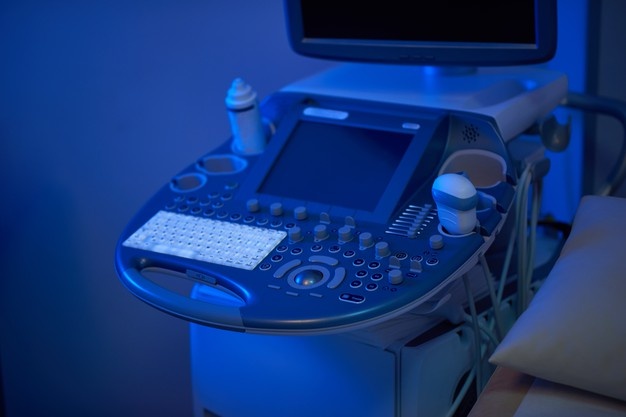
The principle of operation of studies of X-ray equipment remained the same, but the capabilities of modern devices have become significantly wider, which is explained by the introduction of digital technologies, they are completed with additional modules for tomographic studies, various nozzles, kymography, etc. the same X-ray tube, which is a source of invisible rays. In the overwhelming majority of cases, an alternating current network with a voltage of 220 or 126 volts is used as a power source. In some modern complete sets of X-ray models, direct current is used, which improves the quality and detail of images.
Modern X-ray machines consist of the following main units:
- High voltage unit. It consists of a step-up transformer, a transformer that provides an X-ray tube glow.
- X-ray generator (X-ray tube). It is a sealed vessel with a cathode and anode located in it, to which an electric potential is applied. Electrons emitted from the cathode are accelerated in an electric field and rush towards the anode, upon contact with which X-rays are emitted.
- Tripods. The X-ray tube or emitter is fixed to a tripod or tripod system.
- Control block. Equipment designed to control the operating modes of an analog device.
In addition, modern radiographs are equipped with current stabilizers and a protection system that prevents overloading of the emitter. Means are also used to protect others from the dependence of excess radiation.
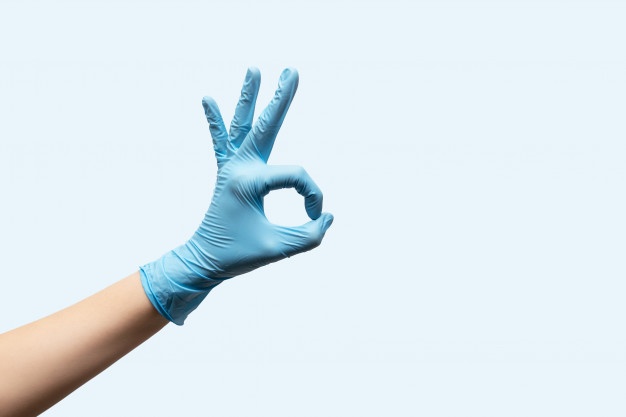
Sterilization equipment
Sterilization equipment is designed to destroy pathogenic and non-pathogenic microflora on medical instruments, dressing materials, linen used in the operating room, in medicinal solutions intended for injection.
The destruction of pathogenic and non-pathogenic microorganisms is carried out using the following sterilization equipment:
- Autoclaves. Apparatus for steam treatment under pressure. They are used for sterilizing instruments and materials that are not sensitive to high humidity. Manufacturers offer units of various sizes – from 15 to 1500 liters. For small offices, tabletop autoclaves are the best choice, and for large institutions, high-performance vertical-type apparatus is suitable. Modern sterilization equipment is equipped with LCDs, interfaces for switching with a personal computer, and the function of automatic recording of the treatments performed. A variety of autoclaves are dry ovens, in which drying, heating of tools and materials is carried out. There are models equipped with forced ventilation, which is mandatory for disinfection of oxidation-resistant substances or products with areas that are difficult to access.
- Plasma sterilizers. Effective against all types of microorganisms. The principle of their operation consists in the treatment of medical devices with plasma with a temperature of 35-60 degrees in the presence of hydrogen vapor. Consumers are offered built-in and floor-standing models of sterilization equipment, equipped with a display and a serial port for communication with a personal computer and other functions.
- Ultrasonic washers. Designed for the pre-sterilization treatment of instruments. The models have a wide functionality and are equipped with tool holders, a drying device, and filtration systems. The control unit allows the operator to program the operation of the device.
Ultrasound machines
Ultrasound machines are a multifunctional computer system for ultrasound diagnostics, which allows you to obtain high-quality two- and three-dimensional images (echograms) and is used to examine diseases of patients in almost all areas of medicine.
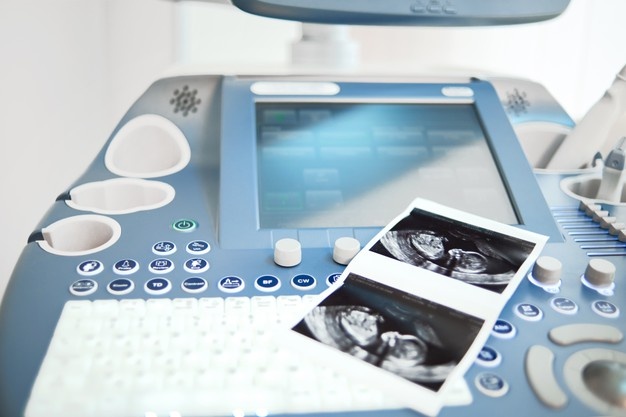
Ultrasound equipment is divided into two types – stationary and portable.
Stationary ultrasound machine. Multifunctional equipment, the operation of which is carried out mainly by a specialist in medical institutions. Stationary systems provide users with ample opportunities in the field of scanning and diagnostics, combining such modern methods as color Doppler, ECG module, volumetric imaging, etc.
Portable ultrasound machine. They are less productive, but their main advantage is mobility. Their small size and weight, combined with a capacious power source, allow them to be used when traveling to non-transportable patients, in ambulances, etc.
In addition, ultrasound devices are classified based on their functionality and purpose:
- universal;
- specialized.
In turn, universal ultrasound machines can be conditionally divided into the following product groups:
- Ultrasound scanners or echography. In the main modes of operation, they allow obtaining an aiming two-dimensional image and a one-dimensional echogram with a time base. Ultrasound mammography allows you to view images of the breast in different projections.
- Ultrasound machine with spectral doppler. The difference between such devices is the ability to analyze blood flow velocity using a Doppler.
- Systems with color Doppler mapping. They are distinguished by maximum functionality and, in addition to the capabilities that are presented in spectral scanners, can display the distribution of blood flow in a two-dimensional model.
Among specialized scanners, the following models can be distinguished:
- Ophthalmic. They allow visualizing the structures of the organs of vision in one- and two-dimensional modes.
- Sinuscopes. Designed for examining the nasal and frontal sinuses.
- Fetal. Used to determine the fetal heart rate using the Doppler method.
- Echoencephaloscopes. A category of devices designed for brain research.
In addition, ultrasound machines are divided into categories that determine the quality of the data obtained as a result of diagnostics: simple, medium, advanced, and high class. Simple devices are overwhelmingly portable 16-channel devices. Middle and higher class – 32- and 64-channel devices. The equipment of the highest class is represented by devices with Doppler mapping and digital processing of results.
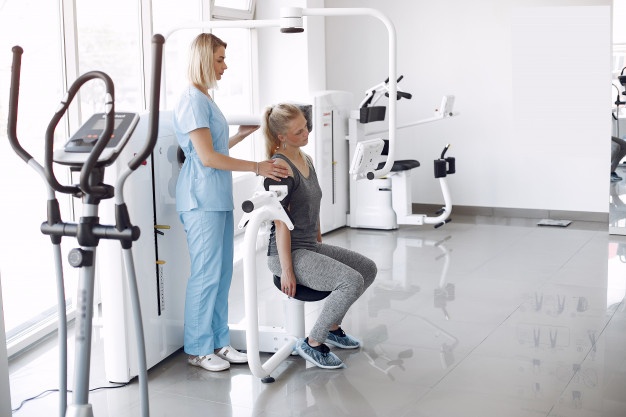
Physiotherapy equipment
Physiotherapy equipment is a separate category of devices and devices used to influence various body systems. Designed for use as part of complex treatment programs and prophylactic purposes.
Physiotherapy equipment is represented by devices for conducting magnetic resonance and ultrasound therapy, inhalers, and other devices that significantly accelerate the process of patient recovery.
The main types of devices for carrying out physiotherapy procedures:
- Inhalers (nebulizers). For inhalation, three main types of inhalers are used: steam, compressor, ultrasonic. In medical practice, the last two types of devices are most often used. Compressor inhalers are considered universal.
- For magnetotherapy and magnetophoresis. Stationary and portable devices for use in physiotherapy rooms and medical institutions. They are widely used in ophthalmology for the treatment of degenerative processes in the fundus, keratitis, eyelash diseases, hemorrhages, etc., as well as in otorhinolaryngology for the treatment of otitis media, laryngitis, frontal sinusitis, etc. dilatation of the veins of the lower extremities.
- Irradiators. Sources of ultraviolet radiation, which are used in the treatment of inflammatory and purulent processes in otorhinolaryngology, joint diseases, rheumatism.
- For UHF therapy. Physiotherapy devices using ultra-high frequency electromagnetic waves. They are widely used in such areas of medicine as neurology, surgery, gynecology, pediatrics, etc.
- For ultrasound therapy. Modern devices generating ultrasound waves, equipped with a microprocessor control unit and provide the ability to adjust some parameters. Used for the treatment and prevention of diseases of the musculoskeletal system, genitourinary organs,
- For electrotherapy. They are used in cosmetology practice, in treatment in sanatoriums, in sports medicine, or for individual purposes in treatment at home. The most functional devices have a large number of operating modes, for example, “electrosleep”, “amplitude therapy”, “fluctuorization”, etc. Scope of application: treatment and prevention of diseases of the nervous system with pain syndrome, diseases of the joints, gastrointestinal tract, lungs, kidneys, as well as bruises, sprains, etc.
Surgical equipment
Modern surgical equipment is represented by various models of devices and devices and is intended for use at all stages of surgical operation. It reduces the risk of possible complications during surgery, supports vital functions, and provides the necessary comfort for doctors, nurses, and patients.

Basic surgical instruments and devices for operating rooms:
- oxygen concentrators;
- coagulators;
- operating microscopes;
- surgical aspirators;
- lamps;
- dispensers.
Oxygen concentrators are designed to extract oxygen from the ambient air. During the operation of the device, oxygen particles are separated from nitrogen, as a result of which concentrated oxygen enters the battery. The air undergoes multi-stage cleaning: from dust, bacteria, molecular. Humidified and purified oxygen is delivered to the patient. The systems are designed for various volumes, can be stationary and mobile, and be used in conjunction with ventilators.
Coagulators are used to quickly stop bleeding during surgery. Under the action of a high-frequency current passing through the tissues of the body, proteins are folded, which leads to a stop of bleeding. There are two main types of coalescers: electric wave and argon. In the first case, the incisions are made using a focused electric current, in the second – using plasma is obtained by the interaction of an electric current with argon.
Operating microscopes are widely used in microsurgery. There are a large number of microscope models (phase-contrast, dark-field, polarization, X-ray, interference, electronic), each of which is used for a thorough study of structural changes in tissues, which significantly improves the quality of diagnostic procedures and treatment.
An aspirator or aspirator is a device for removing biological material from a wound or body cavity of a patient. It is used in surgery to remove mucus, blood during surgery, in gynecology – to remove postpartum secretions or fluids during various procedures, in pulmonology – to release the airways, etc. It is a device equipped with a compressor that creates negative pressure and tubes with a set of tips. Aspirators are stationary and portable, have different power, maximum vacuum, noise level, containers for removed liquids.
For the needs of the operating room, special shadowless mobile and stationary lamps are used, equipped with one or more reflectors, providing sufficient luminous flux and having a low level of thermal radiation.
Medical dispensers are high-tech automatic devices for infusion therapy, which ensure high accuracy of dosing of drugs and their delivery in the required mode.
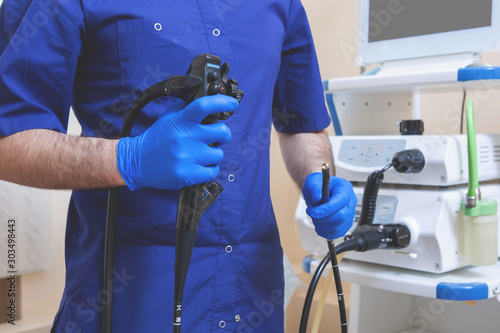
Endoscopic equipment
Endoscopes are optical devices widely used in medicine for therapeutic and diagnostic purposes. With their help, the doctor gets the opportunity to visually assess the state of internal organs and systems, carry out surgery, take tissue samples for biopsy, etc. A medical endoscope is a device in the form of a small diameter tube that is inserted into the patient’s body through incisions or natural openings. At its end, there is a light source and an optical system, the image from which is transmitted to the eyepiece lens.
Depending on the field of application, the following types of endoscopes are distinguished:
- Gastroscope – designed to examine the upper part of the gastrointestinal tract. It differs from other types of endoscopes in the position of the optical system. It can be an end, side, or oblique. The head is rotated in two directions. There are varieties of gastroscopes designed for examining the stomach and duodenum. A gastro-fibro scope can be used to detect bleeding and determine its causes, to remove foreign bodies.
- Colonoendoscope. Allocate equipment for diagnostics and surgical interventions. A diagnostic endoscope is used for examinations to identify signs of various diseases, to clarify the diagnosis. Operating – upon detection of foreign bodies, to eliminate bleeding, intestinal obstruction.
- Bronchoendoscope. Designed for examining the bronchi, trachea, lungs, taking samples for biopsy, identifying signs of various pathologies, etc.
Depending on the design and applied technologies, the following types of endoscopes are distinguished:
- Optic. It is a rigid rod with lenses, at the end of which there is a lens, a light source. Allows the use of a camcorder.
- Fiberscope. The introductory shaft of the device is flexible and made of fiberglass, which allows examining organs located in hard-to-reach places. The rod of the device is thin and fragile, which requires more careful handling.
- Video endoscope. This is an endoscope, the price of which depends not only on the design but also on the video cameras used. It is equipped with a flexible shaft with an end-mounted camera. The design may contain functional channels for entering tools. Some models, for example, video laryngoscopes, can have rigid rods and be equipped with built-in monitors for real-time viewing of images.
Neonatology equipment
The body of newborns is sensitive to external factors: temperature, humidity, pressure, this is due to the imperfection of the center responsible for thermoregulation processes. For just born babies, and especially for premature babies, special equipment is used to create a special microclimate, characterized by constant parameters.
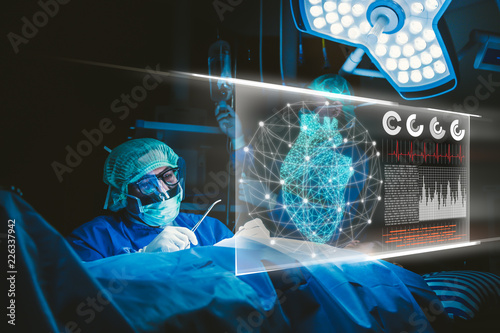
The main neonatal equipment includes:
- Incubators for newborns. Systems with the help of which it is possible to create the most comfortable environment for babies.
- Baby heating equipment. Used to prevent and treat hypothermia.
- Resuscitation complexes. Such equipment combines the functions of an incubator and the ability to carry out the necessary medical measures. Provide the ability to monitor the weight of the newborn, general condition, etc.
- Fiber optic complexes. Systems designed for the treatment of indirect jaundice and the nursing of newborns.
- Medical furniture for newborns. Medical beds for newborns.
- Optional equipment. Electronic scales, height meters, heaters.
The functions of incubators for newborns include maintaining optimal temperature, humidity, and oxygen concentration. This is achieved by cascading air heating in a structure equipped with double walls and an acrylic hood. The system creates optimal conditions for the preservation of radiant heat; there are no restrictions for monitoring the baby. Various manipulations and resuscitation measures can be carried out through special windows in the device. The presence of special sensors for the skin allows you to monitor the body temperature of the child.
There are the following types of incubators:
- Stationary. They are used directly in medical institutions.
- Transport. Designed for transportation of babies in ambulances.
- With a minimal set of functions. Designed to create a comfortable living environment.
- Multifunctional. They allow not only to create the necessary microclimate but also to carry out all types of procedures.
- Transforming. Incubators, in which the possibility of their transformation into a resuscitation complex is realized.
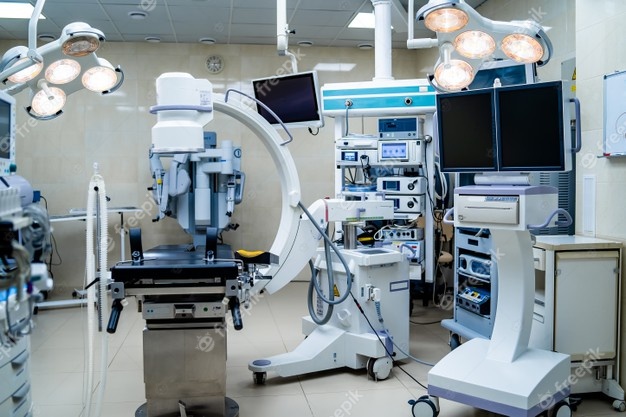
Operating tables
Operating tables on the market today are a symbiosis of functionality, practicality, and thoughtful design. They provide maximum freedom of action for specialists and are used in all areas of medicine: gynecology, neurosurgery, orthopedics, etc. Their functionality and ergonomics are decisive factors for obtaining high results in any surgical intervention, therefore, in each area where they are used, they have been developed their requirements for this category of products.
The classification of operating tables is primarily based on the scope of their application:
- universal;
- orthopedic;
- dressing.
Tables can be stationary or mobile. Mobile structures provide great freedom in choosing their location and in some cases can be used for operations outside the operating rooms.
Operating (surgical) table – a structure that includes the following elements:
- Base. Equipped with a hydraulic or electric drive to change the angle of inclination and height of the product.
- Movable sections. Provide an optimal position for the patient during operations and manipulations. Functional models have 3 to 5 movable sections.
- Drive unit. Used to change the position of sections, table height. Depending on the model, a hydraulic or electric drive can be used.
- Additional elements. Designed to increase the functionality of the product and the level of comfort for doctors and patients. These include palm rests, knee, and footrests, equipment stands, etc.).
The functionality and equipment of the tables vary depending on the model and manufacturer. The most popular among modern consumers are designs that use hydraulic, pneumatic, and electric drives. In the latter case, all adjustments can be made from the control panel.
Universal surgical tables are rich in functionality and adaptability to different conditions of surgical interventions. They are equipped with a wide range of additional options and accessories. Tables with the removable top are also very popular.
As for orthopedic operating tables, they are versatile designs equipped with various orthopedic devices.
